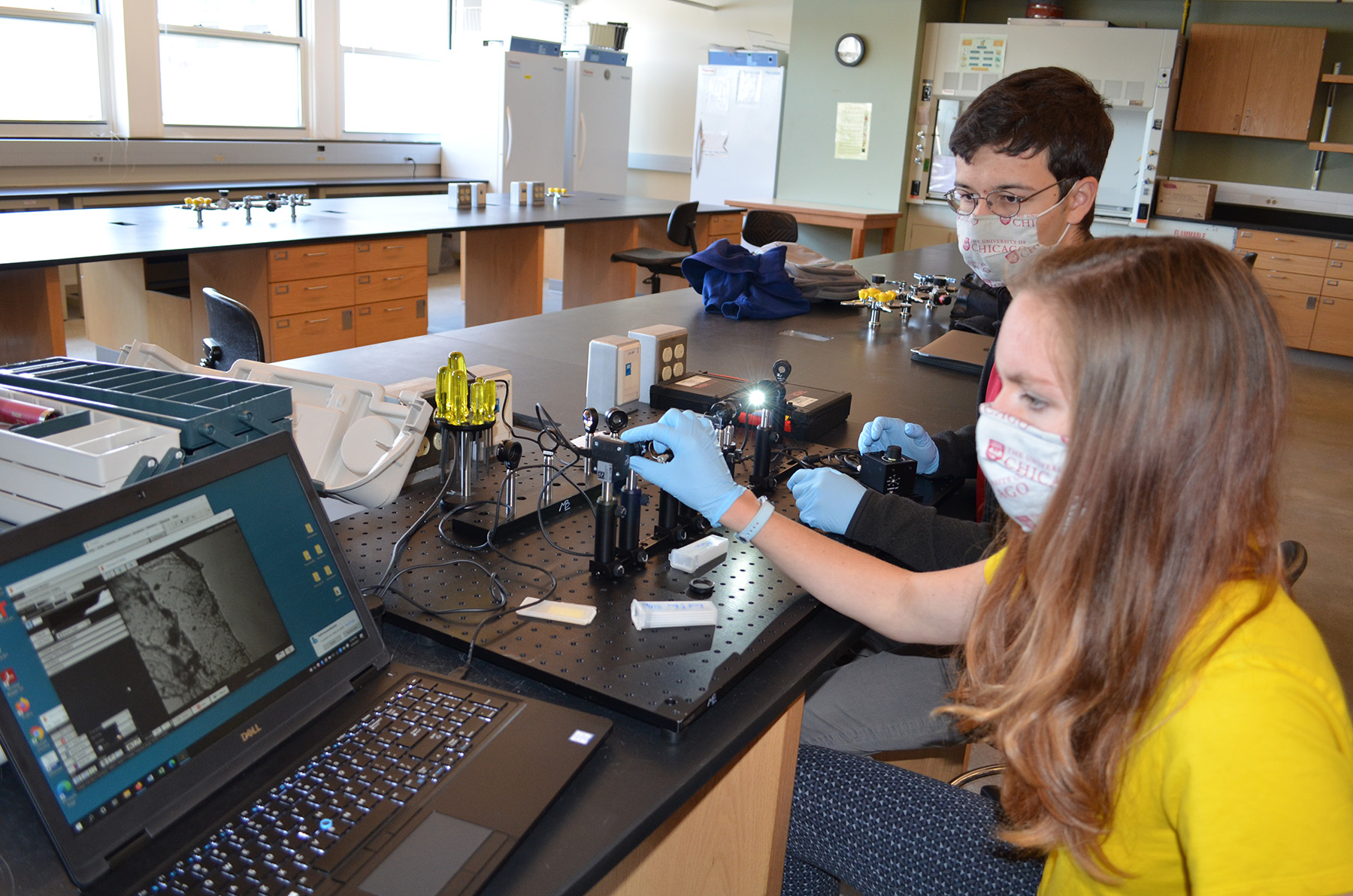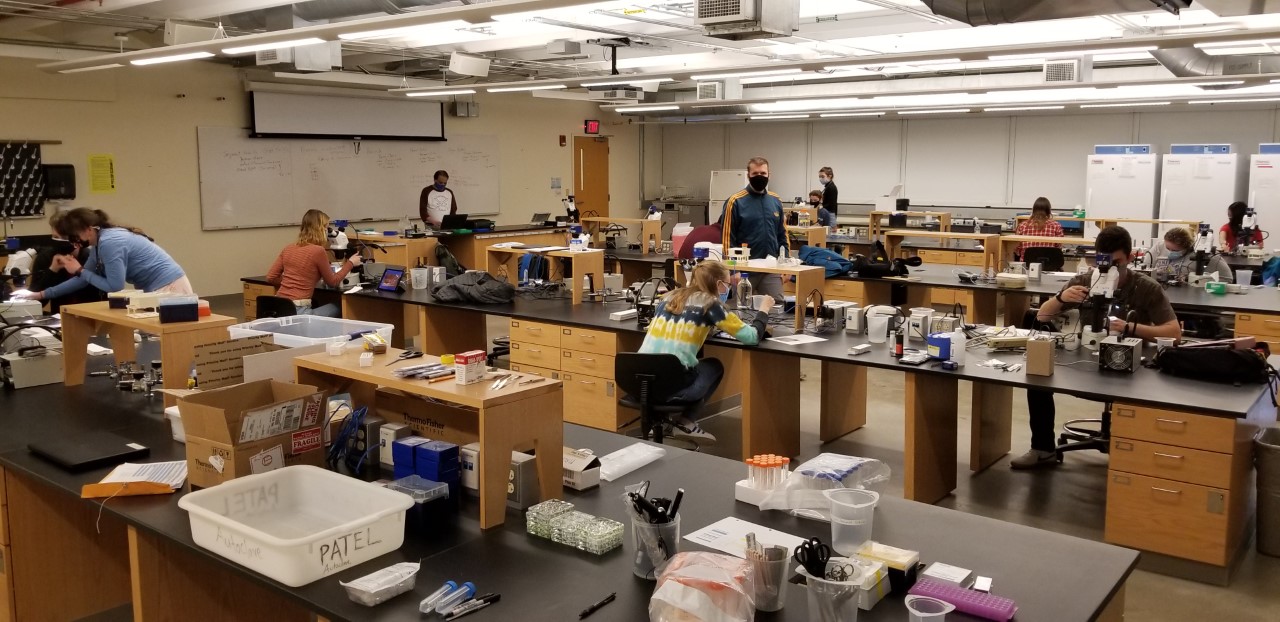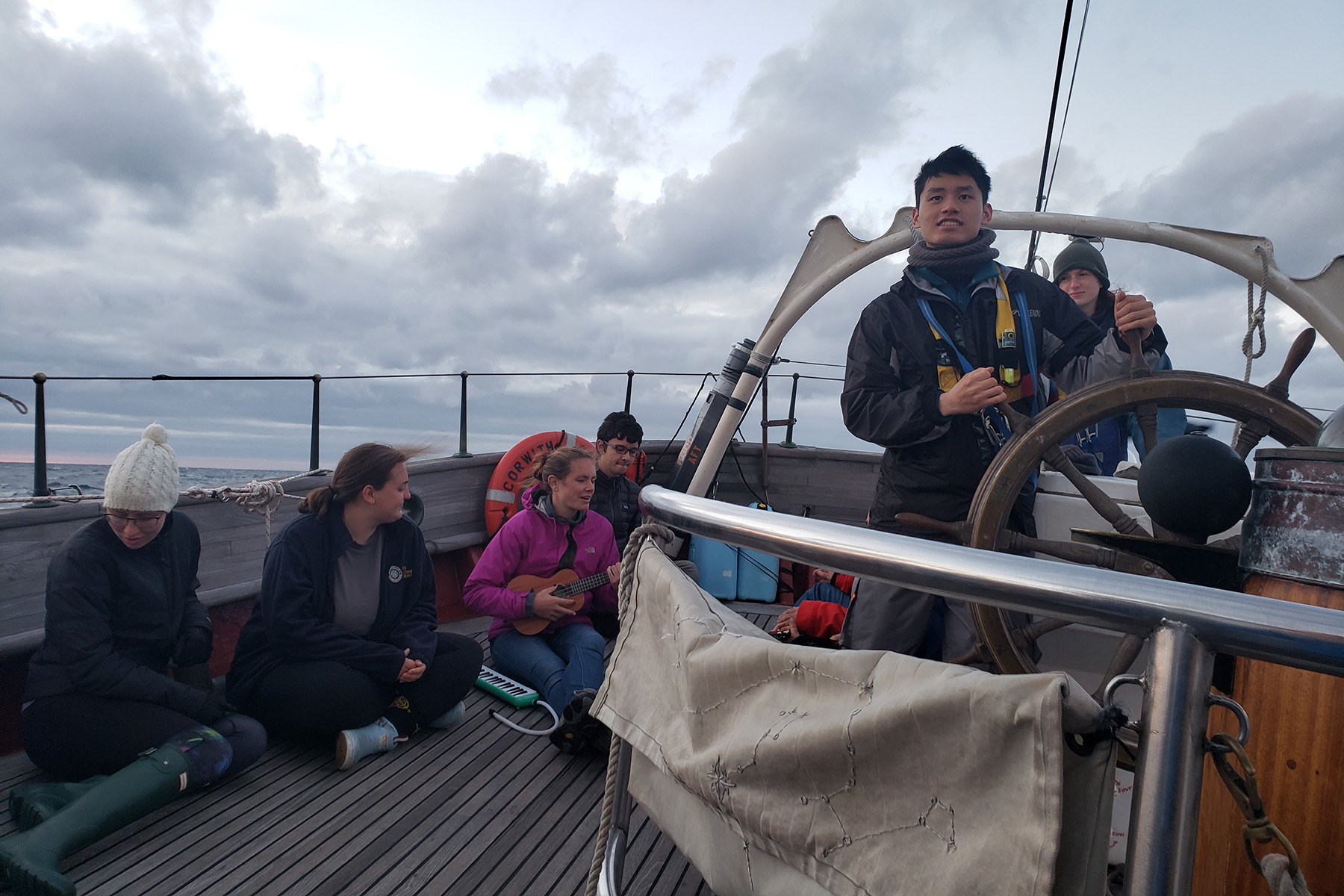UChicago Students Flex Science Muscles in New MBL Courses

In early spring, 12 students from the University of Chicago packed their bags and headed to Woods Hole for an immersive scientific experience at the Marine Biological Laboratory (MBL).
While the pandemic kept the majority of UChicago’s classes online, those participating in the MBL Spring Quarter came together for an action-packed course schedule that included building their own microscopes, leading research experiments, and even going out to sea for a multi-day sampling trip. Like the MBL’s popular Advanced Research Training Courses, the UChicago classes place an emphasis on doing, not just hearing.
“I was excited to have an experience that was really hands-on versus solely lecture based,” said Grace Lehto, first year UChicago student. “It’s been the ideal in-person experience for me.”
 Isabel O’Malley Krohn and Nichos Molnar build a microscope on rails during the Optics, Waves, and Modern Physics course. Credit: Diana Kenney
Isabel O’Malley Krohn and Nichos Molnar build a microscope on rails during the Optics, Waves, and Modern Physics course. Credit: Diana KenneyAn MBL Spin on Optics and Waves
For the first time, students were offered an MBL spin on the University of Chicago’s Physics III course. Optics, Waves, and Modern Physics at the MBL was a three-week module with lectures in the morning and a hands-on lab course in the afternoons. The course was led by MBL’s Rudolf Oldenberg and UChicago’s Patrick La Rivière and Ken Bader.
“We gave the course an MBL flavor by centering the laboratory around student-driven, exploration-based optics and microscopy modules,” said La Rivière, UChicago Professor of Radiology and MBL Fellow. “After mastering the basics of optics and microscope construction, the students developed a new module using polarized light that we will integrate into the course in future years.”
During the module, students helped to assemble an optical rail microscope—the same type of kits used in many of MBL’s Advanced Research Training Courses. But in a new twist, they added polarizing light filters.
“It’s really cool that we’re all at different levels,” said Isabel O’Malley-Krohn. “At UChicago, third years take courses with third years, second years with second years. but here we’re all at different levels...There’s no expectations about what you do and don’t know.”
 MBL Director Nipam Patel (standing at whiteboard) teaches in the Imaging for Biological Research course in spring 2021. Credit: Louis Kerr
MBL Director Nipam Patel (standing at whiteboard) teaches in the Imaging for Biological Research course in spring 2021. Credit: Louis KerrSeeing the Unseen
Another option for MBL Spring Quarter students was Imaging for Biological Research. The course, which was new in Fall 2020, was developed by MBL Director Nipam Patel. Students learn imaging fundamentals and then dive into hands-on lab time in MBL’s state-of-the-art microscopy facilities.
“It’s so cool. Working with the SEM (scanning electron microscope), looking at butterfly scales. I was surprised they let us touch the equipment!” said Branson Scott-Starr, a math major.
“It’s been a cool mix of lab work and interesting materials in the lectures. I highly recommend it,” said Clare Booth, biology major.
From Book Page to Lab Bench
“The new course on Stem Cells and Regeneration was designed to introduce students to the basic idea that the ability to regenerate complex tissue is found in a wide variety of animals,” said course faculty Karen Echeverri, MBL associate scientist in the Eugene Bell Center for Regenerative Biology and Tissue Engineering.
Many animals have evolved pathways to regenerate complex tissue—some activate resident stem cells while others de-differentiate mature cells. During the course the students worked with a range of animals including flatworms, sea anemones, zebrafish, and axolotls.

“Hopefully they now have an appreciation of the value of research organisms to study cellular, developmental and regeneration processes,” said Echeverri.
“You’re working with species you’ve only read about and suddenly they’re on your petri dish and you have to keep them alive,” said Lehto.
The students said being in Woods Hole was a welcome refresher. “It’s a completely different experience. It feels like you’re working, not just studying,” said biology major Nevaeh Petrie. “You’re gaining experience, you’re gaining credits, and you’re getting a mental break from the Chicago campus.”
A Different Point of View
An optional course for the students in the Spring Quarter was an MBL spin on a UChicago classic: Visual Language: On Images. Students learn art fundamentals such as negative space, texture, color, and perspective in this studio course, but also incorporate lessons from MBL scientists.
MBL Director Nipam Patel gave a lecture on pigment and structural color in butterflies. Before a lecture on an artist’s perspective on camouflage, students toured the lab of MBL cephalopod scientist Roger Hanlon and learned how cuttlefish use camouflage to blend in with their surroundings.

“There’s a focus to the work I have been excited to see,” said UChicago lecturer Frances Lee, who ran the On Images course. “There’s a real development of ideas about what we talk about in the class and how that relates to general frameworks for the other science courses that they’re taking.”
At the end of the module, the students created an art installation for everyone on the MBL campus.
“I absolutely recommend taking the art course. It’s a really great twist on a popular UChicago course,” said Petrie.

Science at Sea
The last course option offered a unique opportunity for the students to experience time at sea. Biological Oceanography was led by MBL’s neighbors at the Sea Education Association (SEA). Students embarked on the SSV Corwith Cramer for a 10-day sea voyage after a compressed lesson to learn everything from sailing to sampling techniques. No plan survives contact with the ocean and the students aboard the Corwith Cramer sailed into a low-pressure system with gale force winds and rough seas.
“Conquering these physical challenges, we were able to gather a very nice dataset to evaluate rates of primary productivity, zooplankton biomass, and the underlying physical structuring of the water column both on the [continental] shelf and off,” said SEA Professor of Oceanography Jan Witting, who led the course.
“By the time the students left the ship in Woods Hole, they had not only written strong collaborative papers on their chosen topics, but they had also experienced a full-fledged oceanographic research expedition including all the new skills in gear deployment, lab analysis, and operating the ship itself,” said Witting.
Coming Together
One thing was clear: Being able to be together in person was a big part of why these students chose the MBL Spring Quarter.
“I really missed doing things in person,” said third-year Phoebe Hall. “[During the pandemic,] I went from being in the lab all the time as a biology major to just pushing buttons on simulations.”
Petrie says the quarter gave her a special opportunity to get out of her comfort zone, even during a pandemic. “I was really interested in being abroad, but I didn’t want to go to a foreign country. This let me study in a place I’ve never been,” she said.
“Whether you’re a bio major interested in research and spending all day in the lab or you just want to fulfill your bio credits, you should absolutely do this [Quarter at MBL],” said Booth.
